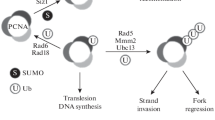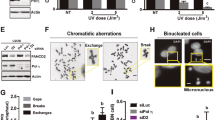Abstract
Exposure of cells to ultraviolet (UV) light damages the genome and the persistence of DNA lesions triggers apoptosis in mammalian cells. RNA transcription blockage by DNA damage is believed to be implicated in signaling for UV-induced apoptosis, but the role played by DNA replication in this process is still unclear. To address this point, we have employed the DNA polymerase inhibitor aphidicolin in UV-irradiated wild-type and XPB-mutated Chinese hamster ovary cells. The data obtained with synchronized cells indicate that induction of apoptosis by UV light is independent of the cell cycle phase. Nevertheless, cells treated with aphidicolin after UV exposure showed a significant prevention of apoptosis induction when compared to proliferating cells. These results were observed in both DNA-repair proficient and deficient cells, indicating that the prevention of apoptosis by aphidicolin is independent of the cells’ ability to repair the photolesions caused by UV. Taken together, these data suggest that replication of damaged DNA also leads to critical events signaling for UV-induced cell death.
Similar content being viewed by others
References
Friedberg EC, Walker GC, Siede W (1995) DNA damage. In: Friedberg EC (ed) DNA repair and mutagenesis, vol 1. ASM Press, Washington, pp. 1–47
Bender K, Blattner C, Knebel A, Iordanov M, Herlich P, Rahmsdorf HJ (1997) UV-induced signal transduction. J Photochem Photobiol 37:1–17
Martin SJ, Green DR (1995) Proteases activation during apoptosis: Death induced by a thousand cuts? Cell 82:349–352
Saini KS, Walker NI (1998) Biochemical and molecular mechanisms regulating apoptosis. Mol Cell Biochem 178:9–25
Costa RM, Chiganças V, Galhardo RS, Carvalho H, Menck CFM (2003) The eukaryotic nucleotide excision repair pathway. Biochimie 85:1083–1099
Ma L, Hoeijmakers JHJ, van der Eb AJ (1995) Mammalian nucleotide excision repair. Biochim Biophys Acta 1242:137–163
Lehmann AR (2003) DNA repair-deficient diseases, xeroderma pigmentosum, Cockayne syndrome and trichothiodystrophy. Biochimie 85:1101–1111
Chiganças V, Miyaji EN, Muotri AR, Jacsyn JF, Amarante-Mendes GP, Yasui A, Menck CFM (2000) Photorepair prevents ultraviolet-induced apoptosis in human cells expressing the marsupial photolyase gene. Cancer Res 60:2458–2463
Chiganças V, Batista LFZ, Brumatti G, Amarante-Mendes GP, Yasui A, Menck CFM (2002) Photorepair of RNA polymerase arrest and apoptosis after ultraviolet irradiation in normal and XPB deficient rodent cells. Cell Death Differ 9:1099–1107
Menck CFM (2002) Shining a light on photolyases. Nat Genet 32:338–339
Li YF, Kim ST, Sancar A (1993) Evidence for lack of DNA photoreactivating enzyme in humans. Proc Natl Acad Sci USA 90:4389–4393
Thompson CL, Sancar A (2002) Photolyase/cryptochrome blue-light photoreceptors use photon energy to repair DNA and reset the circadian clock. Oncogene 21:9043–9056
Lindahl T, Satoh MS, Poirier GG, Klungland A (1995) Post-translational modification of poly(ADP-ribose)polymerase induced by DNA strand breaks. Trends Biochem Sci 20:405–411
Lehmann AR (2002) Replication of damaged DNA in mammalian cells: New solutions to an old problem. Mutat Res 509:23–34
Friedberg EC, Wagner R, Radman M (2002) Specialized DNA polymerases, cellular survival, and the genesis of mutations. Science 296:1627–1630
Miyaji EN, Menck CFM (1995) Ultraviolet-induced cell death is independent of DNA replication in rat kangaroo cells. Photochem Photobiol 61:454–458
McKay B, Becerril C, Spronck J, Ljungman M (2002) Ultraviolet light-induced apoptosis is associated with S-phase in primary human fibroblasts. DNA Repair (Amst) 1:811–820
Dunkern TR, Kaina B (2002) Cell proliferation and DNA breaks are involved in ultraviolet light-induced apoptosis in nucleotide excision repair-deficient chinese hamster cells. Mol Biol Cell 13:348–361
Spadari S, Pedrali-Noy G, Ciomei M, Falaschi A, Ciarrocchi G (1984) Control of DNA replication and cell proliferation in eukaryotes by aphidicolin. Toxicol Pathol 12:143–148
Balajee AS, May A, Dianov GL, Friedberg EC, Bohr VA (1997) Reduced RNA polymerase II transcription in intact and permeabilized Cockayne syndrome group B cells. Proc Natl Acad Sci USA 94:4306–4311
Amarante-Mendes GP, Bossy-Wetzel E, Brunner T, Green DR (1998) Apoptosis essays. In: Spector DL, Goldman R, Leiwand L (eds) Cell: A laboratory manual, vol 15. Cold Spring Harbor Laboratory Press, Cold Spring Harbor, pp 3731–3737
Chiganças V, Sarasin A, Menck CFM (2004) CPD-photolyase adenovirus-mediated gene transfer in normal and DNA-repair-deficient human cells. J Cell Sci 15:3579–3592
Nakajima S, Lan L, Kanno et al (2004) UV light-induced DNA damage and tolerance for the survival of nucleotide excision repair-deficient human cells. J Biol Chem 279:46674–46677
Ljungman M, Lane DP (2004) Transcription—guarding the genome by sensing DNA damage. Nat Rev Cancer 4:727–737
Donahue BA, Yin S, Taylor JS, Reines D, Hanawalt PC (1994) Transcript cleavage by RNA polymerase II by a cyclobutane pyrimidine dimer in the DNA template. Proc Natl Acad Sci USA 91:8502–8506
Ljungman M, Zhang F (1996) Blockage of RNA polymerase as a possible trigger for u.v. light-induced apoptosis. Oncogene 13:823–831
Carvalho H, Costa RMA, Chiganças et al (2003) Effect of cell confluence on ultraviolet light apoptotic responses in repair deficient cells. Mutat Res 544:159–166
Halicka HD, Huang X, Traganos F, King MA, Dai W, Darzynkiewics Z (2005) Histone H2AX phosphorylation after cell irradiation with UV-B. Cell Cycle 4:124–130
Konishi A, Shimizu S, Hirota et al (2003) Involvement of histone H1.2 in apoptosis induced by DNA double-strand breaks. Cell 114:673–688
Hammond EH, Green SL, Giaccia AJ (2003) Comparison of hypoxia-induced replication arrest with hydroxyurea and aphidicolin-induced arrest. Mutat Res 532:205–213
Author information
Authors and Affiliations
Corresponding author
Additional information
This work was supported by FAPESP (São Paulo, Brazil), CNPq (Brasília, Brazil), CAPES (Brasilia, Brazil) and COFECUB (Aix en Provence, France). CFMM is a Fellow from the John Simon Guggenheim Memorial Foundation (New York, USA).
Rights and permissions
About this article
Cite this article
Batista, L.F.Z., Chiganças, V., Brumatti, G. et al. Involvement of DNA replication in ultraviolet-induced apoptosis of mammalian cells. Apoptosis 11, 1139–1148 (2006). https://doi.org/10.1007/s10495-006-7109-4
Published:
Issue Date:
DOI: https://doi.org/10.1007/s10495-006-7109-4




